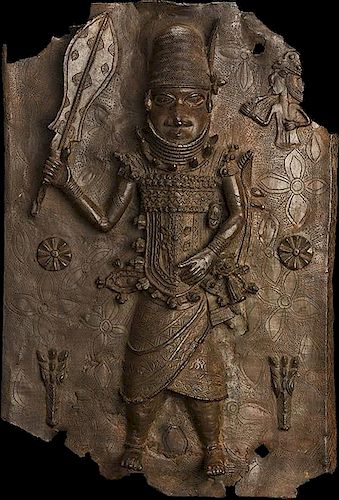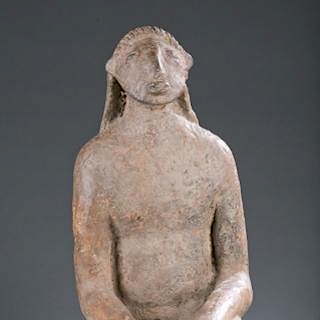Benin brass plaque with single figure.
About Seller
360 S. Washington Street
Falls Church, VA 22046
United States
Quinn's Auction Galleries is a full service auction and estate services company. We have a range of specialties, from fine art & antiques, to rare books & maps.
Two ways to bid:
- Leave a max absentee bid and the platform will bid on your behalf up to your maximum bid during the live auction.
- Bid live during the auction and your bids will be submitted real-time to the auctioneer.
Bid Increments
| Price | Bid Increment |
|---|---|
| $0 | $10 |
| $300 | $25 |
| $500 | $50 |
| $1,000 | $100 |
| $3,000 | $250 |
| $5,000 | $500 |
| $15,000 | $1,000 |
| $20,000 | $2,000 |
| $30,000 | $2,500 |
| $100,000 | $5,000 |
About Auction
Oct 1, 2016 - Oct 2, 2016
Quinn's Auction Galleries dquinn@quinnsauction.com
- Lot Description
A plaque representing a warrior chief. Benin Kingdom, Nigeria. 16th century. 19 1/8ï¾” x 33 1/16ï¾” (48.58 cm x 33.18 cm).The plaque has been authenticated by ancient art expert John A. Buxton, ISA CAPP, and Kathy Curnow, PhD and Associate Professor, African Art History, Cleveland State University. It also has undergone a rigorous forensic examination by Mark Rasmussen of Rare Collections, a firm that provides scientific investigation and research services to leading museums and private collection.
Provenance: Inventory and Collection from the Estate of Merton D. Simpson. Catalog Notes: This copper-alloy plaque is one of over 800 extant examples that once adorned wooden gallery roof supports around a large reception courtyard in Beninï¾’s palace. Their presence represented an awe-inspiring display of resources, as the metal alone was a luxury import. Members of the royal casting guild made the majority of the plaques during the reign of Oba Esigie, who ruled from 1517- late 16th century (Curnow in Levenson, 2007: 76). Most of these lost-wax casts were made in essentially identical pairs, though some of their details differ. A double-woven interlace design decorates this plaqueï¾’s side flanges, which Kathryn Gunsch suggests, is the mark of the guild head in the third and final phase of plaque production (2014). The single figure of a warrior chief is here frontally positioned and centered on a stippled abstract field patterned with river leaves. The composition is typical, although examples with multiple figures, animals, and objects also exist. Three types of ornaments found on numerous plaques stand in relief around its perimeter: a long-haired Portuguese half-figure in profile, somewhat more caricatured than usual, a rosette, and a crocodile head. The warriorï¾’s high, beaded odigba collar (a chiefly prerogative) underlines his status, while the flat band on his shoulders, punctuated by leopardsï¾’ teeth, serves as a mark of soldierly rank. The hilt of his umozo war sword projects under his left arm. At his left hip, where his embroidered or brocaded wrapper closes, he wears a sash, rounded bell, and a brass pendant in the shape of a face. This latter appears to have a truncated, flattened body with projecting arms and legs, though these simply may be tassels or crotals. Chiefly hip pendants are still worn; sixteenth-century specimens most commonly represented enemy or leopardï¾’s heads. The latter, like the figureï¾’s toothed band and leopard skin jerkin (or its cloth imitation), indicate the monarch sanctioned soldiersï¾’ taking of human life, for the deadly feline was a kingly metaphor. The chief raises the ?b?n, his ceremonial dance sword, indicating his participation in a palace ceremony. This festival was likely Isiokuo, the now-defunct celebration of Ogun, deity of war, and the supernatural medicines that promoted victory (Curnow, 2016: 141 and forthcoming). One of the figureï¾’s less-typical features is his basketry hat, an accessory that has led some scholars to identify him with Edogun, the third-ranked war leader. Although the contemporary Chief Edogun is now the only notable to own this hat type (wearing it during the Ugie Iron festival), it was not unique when the plaque was cast. Two identically-dressed military men on a British Museum plaque (Af1898,0115.104), both in leopard-skin wrappers, wear the same headgear. Like this figure, their hip pendants are somewhat atypical. One is in the shape of a leopardï¾’s skull, while the other is a human face, arms extending directly from the head. This represents Ofoe, messenger of Death. A similar warrior pair appears on a plaque in Stockholmï¾’s Ethnographic Museum (1900.01.0002), and, like all the aforementioned figures, each bears a mark on the upper arm, confined to the shape of a rectangle. This is likely scarification, meant for the insertion of protective medicine. Additional plaques show warriors with basketry hats whose dress indicates lesser rank, as well as others with beaded decoration, a mark of distinction. This plaque was formerly in the British Museum collection (Read and Dalton, Pl. XV), but was deaccessioned in the mid-20th century. Missing segments on its right proper mid-section and between the ?b?n and head have been filled in through restoration; likewise, its right proper rosette is a replacement. Within the past century, minor additional loss has occurred in the lower left and upper right proper corners. The original figure remains, however, a skillfully modeled rendering of an officer and courtier in permanent homage to his ruler. - Shipping Info
-
Shipping and Handling Policy:
Quinn's Auctions ONLY ships with FedEx Domestic and USPS internationally. We do not ship Media Mail. Shipping costs are based on the weight of your lots and your location. We require a complete shipping address and phone number to process your shipping quote. You will receive your shipping quote in your invoice via your registered email with a tracking number if available. Once payment is received Quinns will ship items FedEx ground in the United States, USPS International or release items to an outside shipper.Quinn's Auctions reserves the right to recommend an outside shipper based on fragility and size of lot. We offer recommendations for outside shipping by trusted shippers if necessary. If using an outside shipper Quinn's Auctions is not responsible for damages by carriers or packers of purchased lots, whether or not recommended by Quinn's Auctions and will not be liable for any losses which result.
-
- Buyer's Premium



 EUR
EUR CAD
CAD AUD
AUD GBP
GBP MXN
MXN HKD
HKD CNY
CNY MYR
MYR SEK
SEK SGD
SGD CHF
CHF THB
THB













